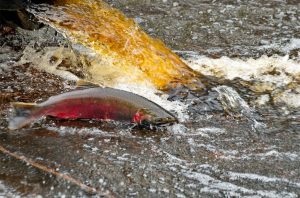[ad_1]
What biotechnological innovation should we not miss in January? Permeable pavements capable of capturing pollutants and contaminants from tire abrasion…
More than 1.5 million tons of particles from tire wear are emitted each year in the United States alone. These particles account for nearly 30% of microplastics released into the environment, and represent 5 to 10% of all those found in the world’s oceans. After accumulating on roads and parking lots, they are transported to aquatic ecosystems by rainwater. However, beyond plastic pollution, some of these particles are extremely toxic to local wildlife. Thus, the anti-ozonant 6PPD, which delays the degradation rubber tires, transforms into 6PPD-quinone (or 6PPDQ) under the effect of ozone or sunlight. This chemical is fatal for coho salmon (Oncorynchus kisutch), and particularly for future broodstock. Faced with environmental danger, Chelsea Mitchell and Anand Jayakaran, both members of Washington State University in Pullman (United States), sought an effective way to remove these pollutants from the environment before they reach urban rivers…

Permeable pavements to the rescue of coho salmon
Impervious pavements form a real avenue for contaminants from car tires. What if we made them permeable? This is the idea put forward by the two researchers based in Pullman. Their permeable pavement consists of a porous top layer, with connected void spaces to let water infiltrate, laid on a layer of gravel, itself overlooking an underground drain capable of capturing the effluent. During the experiments carried out at IDEA (Industrial Design Engineering and Art) High School in Tacoma, the scientists were able to test their system designed from concrete and asphalt, with and without hardened carbon fibers, the latter aiming to improve the resistance of the whole, weakened by the porosity of the material.
After their tests carried out between August 23 and 25, 2021, Chelsea Mitchell and Anand Jayarakan were able to analyze the results… and rejoice! Their permeable pavement retained more than 96% of the mass of particles from tires, and between 14 and 100% of their soluble chemicals. As for 6PPDQ, they observed an average reduction in its mass of 68%. The conclusion, presented on January 15, 2024 in the journal Science of The Total Environment, suggests that the invention of the two researchers could provide a type of green infrastructure for the rainwater treatment. Especially since the carbon fibers played their reinforcing role perfectly! A promising first step towards deployment on high-traffic roads, where the environmental risk is greatest.
[ad_2]
Source link